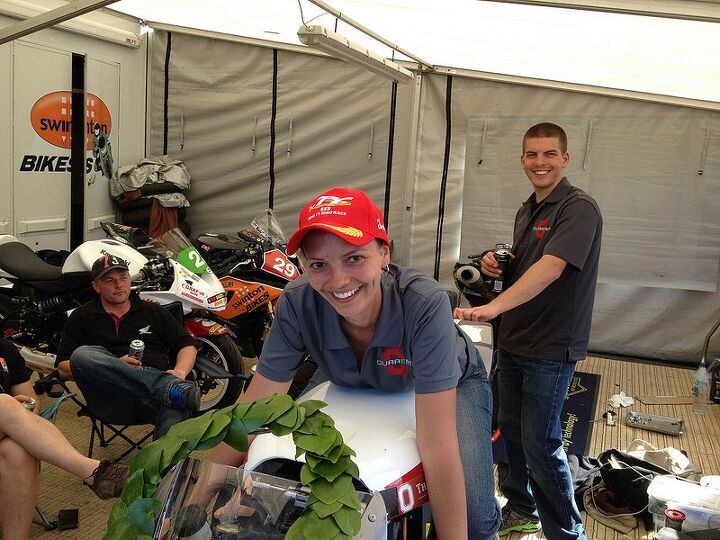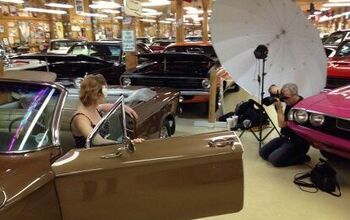The Truth About Caroline: The Life Of Julia

“Things they teach you in the classroom don’t matter until you have a chance to apply them.” So says Julia Cline, an incredibly bright and impressive woman. And for the past three years, Julia has been doing quite a bit of applying.
In the Fall of 2010, two students at The Ohio State University, Sean Ewing and Kyle Ginaven, had a dream of competing in the newly-created TT Zero class at the Isle of Man TT Races, one of the oldest and most prestigious motorcycle races in the world. The class was designed, according to the regulations, for “motorcycles to be powered without the use of carbon based fuels and have zero toxic/noxious emissions.” They posted an advertisement on campus, seeking students who would be interested in helping them build an electric sportbike. Eventually, they were successful in creating what is now called Buckeye Current, an electric motorcycle team founded through the university’s Center for Automotive Research.
“I saw the posting and I immediately signed up,“ says Cline, a non-traditional undergraduate Electrical and Computer Engineering student who already holds bachelors and Masters degrees in Music Education and Curriculum and Instruction. “For the first year, I was essentially a wrench monkey, working on the bike itself, doing whatever needed to be done.” The first bike they engineered was called RW-1, which started life as a 2007 MV Agusta F4. Fitted with an electric motor, motor controller, and battery pack, RW-1 set a collegiate electric motorcycle top speed record in 2011 of 112.349 MPH in Maxton, NC, piloted by Jennifer Holt, an Ohio State grad student and experienced motorcyclist.
“The bike originally had batteries designed for RC airplanes,” laughs Cline. “Loads of them.” In Autumn 2011, Cline became a co-leader of the team with Ginaven and completely reorganized and restructured the team. RW-1 was fitted with new lithium cobalt batteries, and the team designed, built, and tested the new battery back with the specific purpose of achieving maximum speeds.
Having set straight line speed records, Cline and the team refocused on the original goal of Ewing and Ginaven- The Isle of Man TT Races. They built a new bike, codenamed RW-2, which had been a 2006 Honda CBR 1000RR in a past life. The Australian motor controller was taken from RW-1, a new lightweight EMRAX motor was purchased from Slovenia, and the team developed a battery management system which governed the new battery modules from Chinese sponsor Advanced Energy. Current had contacted Suzuki Great Britain World Superbikes rider (and 2009 TT Zero winner) Rob “The Bullet” Barber in 2011 to see if he would be interested in riding RW-1 in the Isle of Man TT, and although RW-1 never made it the TT, Barber stayed in contact with Cline and they came to an agreement to have him be at the helm of RW-2 for the 2013 TT.
The Isle of Man TT Races are held on quite possibly the most difficult motorcycle course in the world, the 37.8-mile long Mountain Course. Every obstacle imaginable can be found—walls, poles, jumps, bridges, manholes—you name it, the Mountain Course has it. It would take a racer of Barber’s capabilities to not only successfully navigate the course, but to do it in a fashion that would achieve Current’s goal for the bike—an average speed of 100 miles per hour and a podium finish. Cline and the rest of the Current team packed up RW-2 and headed across the ocean for the TT, where Barber raced around the course to qualify at an average speed of 91 MPH.
“Every bike has a transponder, but the electrical interference coming from these bikes is very strong,” explains Cline. “The only accurate measurement the officials can really get is the time crossing the Start Line and again crossing the Finish Line.”
“We’re now in the process of evolving the bike. The new project is called RW-2.x. In my new role as technical team lead, I now have a very high-end view of design integration and project management. For instance, we are working to obtain new battery sponsorship that meets our motor controller’s technical requirements and our team goals. However, as a senior at OSU, my engineering capstone project involves me writing a new code for a CAN interface, so that we can translate analog information from the thermistors, battery cells, GPS, suspension travel and other readings into digital information that the data recorder can understand. We’re using a Texas Instruments Piccolo chip with C-based software, and some of our own circuitry designs for additional hardware.” Cline is clearly not your typical female student, and I asked her about her role as a female ECE, not only for Current but in her internship role as a Quality Engineer at a Tier 1 Honda supplier.
“There just aren’t as many female engineers in the automotive workplace as there are male engineers—and that’s okay. If there were, I’d be concerned about the draw to the industry, because we don’t make up nearly as much of the engineering student population. I’ve seen statistics showing that Ohio State has a record enrollment of females in the engineering fields, something like 18%. However, not many of those women are choosing Mechanical or Electrical Engineering. They’re more likely to choose Bio-Medical or Industrial Systems. Of the twenty-five Buckeye Current team members, only two of us are women engineering students.
When I asked Cline what her biggest challenges were, she responded candidly:
“Funding. One of the biggest strengths I brought to the team was my prior fundraising experience from working in the music and not-for-profit industry. We get limited funding from the University. While CAR is able to provide us an office and a place work on the bike, they only give us a little money for materials. So everything else in our race-focused design-built-test cycle has to come from the outside. For example, we lost our battery sponsor, so we’re actively seeking a new one as we speak.
“Also, since we are nearly all undergraduates, that means we graduate our best talent yearly. We are constantly losing our most qualified people and constantly having to train new members of the team. This is an all-volunteer team. They get paid nothing. They receive no college credit. But the hands-on experience that I have gotten has been the real prize. We’ve been exposed to the highest-caliber professional racing teams in the world, and we’ve competed with and beaten them.”
This Life of Julia has taken her around the world, and her ingenuity and team leadership has won her several awards, including the Arcelor Mittal Leadership Award, presented to her at the 33rd annual Women in Engineering Recognition Banquet earlier this year. Cline is set to graduate soon, and while there’s no doubt she’ll be missed by the team, some lucky automaker is going to get their hands on one hell of an engineer.

More by Caroline Ellis
Latest Car Reviews
Read moreLatest Product Reviews
Read moreRecent Comments
- Turbo Is Black Magic My wife had one of these back in 06, did a ton of work to it… supercharger, full exhaust, full suspension.. it was a blast to drive even though it was still hilariously slow. Great for drive in nights, open the hatch fold the seats flat and just relax.Also this thing is a great example of how far we have come in crash safety even since just 2005… go look at these old crash tests now and I cringe at what a modern electric tank would do to this thing.
- MaintenanceCosts Whenever the topic of the xB comes up…Me: "The style is fun. The combination of the box shape and the aggressive detailing is very JDM."Wife: "Those are ghetto."Me: "They're smaller than a Corolla outside and have the space of a RAV4 inside."Wife: "Those are ghetto."Me: "They're kind of fun to drive with a stick."Wife: "Those are ghetto."It's one of a few cars (including its fellow box, the Ford Flex) on which we will just never see eye to eye.
- Oberkanone The alternative is a more expensive SUV. Yes, it will be missed.
- Ajla I did like this one.
- Zerofoo No, I won't miss this Chevrolet Malibu. It's a completely forgettable car. Who in their right mind would choose this over a V8 powered charger at the rental counter? Even the V6 charger is a far better drive.





































Comments
Join the conversation
I always wondered what happened in that CAR building on the edge of campus. I saw the EV charging stations, but never much more. I wonder if they ever open up for tours...
If you're brave enough to invite an internet stranger over, I'd be thrilled to have a look around. I am easily found by tacking my handle onto a gmail address.